Lesson 27
Manage Printers and Scanners
In this lesson, you learn how macOS works with different print and scan technologies and how to manage and troubleshoot printers and multifunctioning devices connected to your Mac.
Reference 27.1
Printing in macOS
macOS uses a combination of AirPrint and CUPS technologies to enable you to quickly set up printers.
AirPrint
AirPrint is an Apple technology that helps you find printers and then print full-quality output without downloading or installing printer drivers (software that allows computers to communicate with printers).
AirPrint is built into most popular printer models, which are listed in Apple Support article HT201311, “About AirPrint,” updated regularly. If your printer was made in the last several years, it probably works with AirPrint.
If your printer isn’t AirPrint-enabled, you can make sure it’s compatible with macOS Big Sur by checking with the printer manufacturer.
CUPS
macOS uses the open source CUPS printing system to manage local printing. CUPS uses the Internet Printing Protocol (IPP/2.1) standard to manage print tasks and PostScript Printer Description (PPD) files for printer drivers. PPD files can describe PostScript and non-PostScript printers.
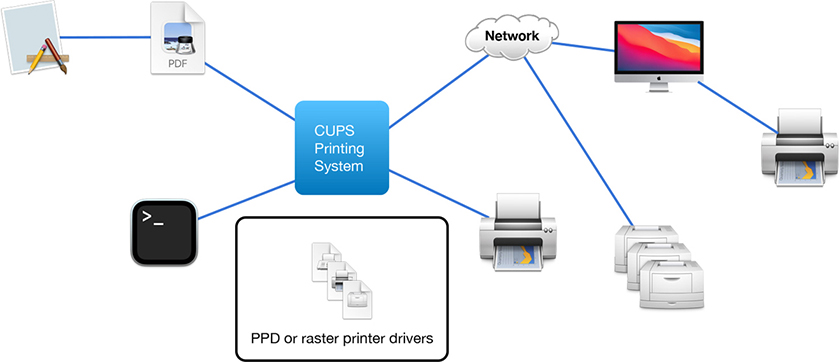
A print job starts when you print from an app or use a print command from Terminal. macOS generates a file called a spool file and places it in the /private/var/spool/cups/ folder.
The CUPS background process, cupsd, passes the spool file through filter processes known as the print chain. These processes convert the spool file to a format that is understood by the destination printer and communicate the information to the printer. To find out more about CUPS, see the official CUPS website at www.cups.org.
Printer Drivers
For printers that don’t support AirPrint, you must associate an appropriate printer driver with the printer before you can use the printer.
Apple supplies printer drivers for most popular printer models, including Brother, Canon, Epson, Fuji-Xerox, HP, Lexmark, Ricoh, and Samsung.
New installations of macOS include only Apple and generic print drivers. macOS upgrade installations also install drivers for printers already in use by the Mac.
macOS also includes support for standard PostScript and Printer Command Language (PCL) printers.
Third-party printer drivers are installed to /Library/Printers/PPDs/Contents/Resources. This folder might contain other vendor folders that include ancillary printer driver resources.
After you add a printer configuration, a copy of the PPD with the name of the device is placed in the /private/etc/cups/ppd folder and two configuration files are modified:
 /private/etc/cups/printers.conf
/private/etc/cups/printers.conf /Library/Preferences/org.cups.printers.plist
/Library/Preferences/org.cups.printers.plist
The first time you print or access a printer queue, macOS creates a printer queue app, with the name of the device, in ~/Library/Printers in the user’s home folder.
Reference 27.2
Configure Printers and Scanners
The way you add and configure a printer on your Mac depends on the printer and how your Mac connects to it:
 AirPrint-enabled printers that are directly connected to your Mac—macOS automatically adds and configures them.
AirPrint-enabled printers that are directly connected to your Mac—macOS automatically adds and configures them. AirPrint-enabled printers that are on your local network—You can add them with a little extra configuration.
AirPrint-enabled printers that are on your local network—You can add them with a little extra configuration. Printers that don’t support AirPrint—You may have to choose the connection type, which printer driver to use, or even download and install a printer driver.
Printers that don’t support AirPrint—You may have to choose the connection type, which printer driver to use, or even download and install a printer driver.
For best results when you add a new printer, enable the option “Automatically keep my Mac up to date” in Software Update preferences and add printers while you are logged in as an administrator user. Software Update is covered in Lesson 6, “Update macOS.”
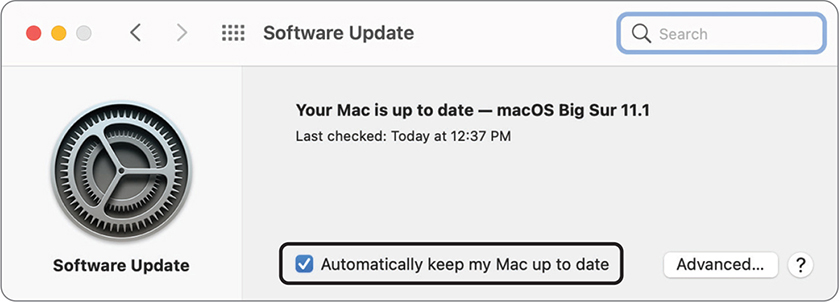
Note ![]()
If you want a user to be able to add and remove printers without providing administrator credentials, make that user a member of the lpadmin group. The man page for dseditgroup has more information.
Configure a Directly Attached Printer
Note ![]()
If you have an AirPrint-enabled printer, don’t install software or drivers from the printer manufacturer. If you install printer software that you didn’t get from Apple, your printer’s software may not be updated automatically when you use Software Update.
Connect your AirPrint-enabled printer to your Mac with an appropriate cable. It doesn’t matter what kind of user account you’re logged in to your Mac with; macOS automatically configures the printer.
If your directly attached printer isn’t AirPrint-enabled, contact the printer manufacturer for instructions on how to get and install printer drivers. Then connect the printer to your Mac.
However, if you have an older printer that doesn’t support AirPrint driverless technology, be sure to log in as an administrator before you continue trying to configure the printer.
Your Mac might automatically install the driver software needed to use that device. For some older printers, your Mac displays a message asking you to download new software. In this case, be sure to click Install to download and install it.
If the “Automatically keep my Mac up to date” option is disabled in Software Update preferences, you can attach the printer to your Mac, then open Software Update to check for printer drivers. If printer drivers are available for the printer, Software Update installs printer drivers silently. You can close Software Update preferences and continue to configure the printer.
If a non-administrator user attaches a new printer for the first time, macOS won’t configure the printer if the driver is missing. Also, if a printer driver for a directly attached printer is unavailable from Apple, then when you plug it in, macOS won’t recognize the printer. In this case, you must manually acquire and install the printer driver with administrator credentials.
You can verify the printer was added by opening the Print dialog from any app (File > Print) or from Printers & Scanners preferences. In Printers & Scanners preferences, you can tell that a printer is locally connected if its location has the same name as the Computer Name (configured in Sharing preferences) for your Mac.
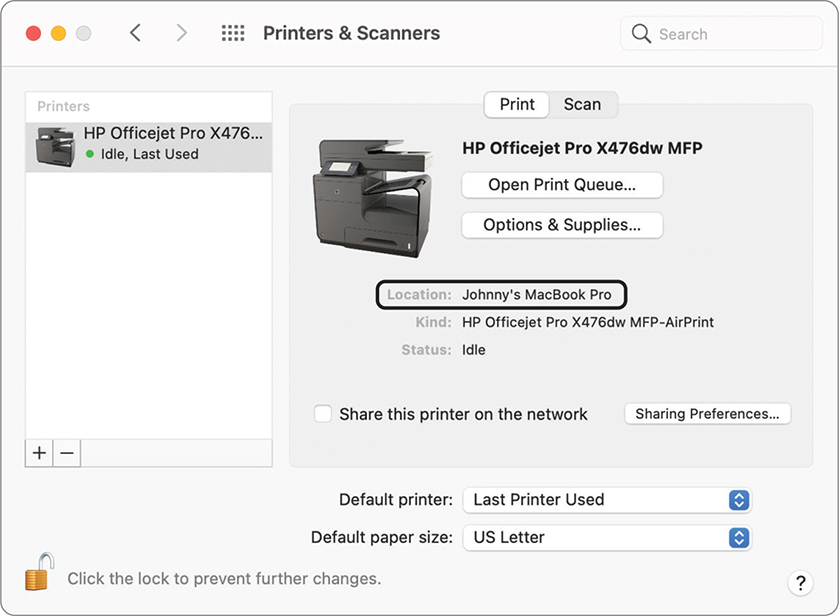
Configure a Local Network Printer
You must be logged in on your Mac with an administrator account to add a local network printer. If your Mac and printer are already connected to the same local network, the printer might be available to you without any setup. macOS can automatically discover standalone printers that support Bonjour (also known as mDNS), standalone printers that support AirPrint, and any printer shared from another Mac or AirPort wireless base station. If your network printer isn’t AirPrint-enabled, use Software Update preferences to install available printer drivers.
One way to add and configure a network printer that your Mac discovers on your local network is with the following steps:
Open an app that enables you to print.
Choose File > Print.
Open the Printer menu, then in the Nearby Printers section of the menu, choose your printer.
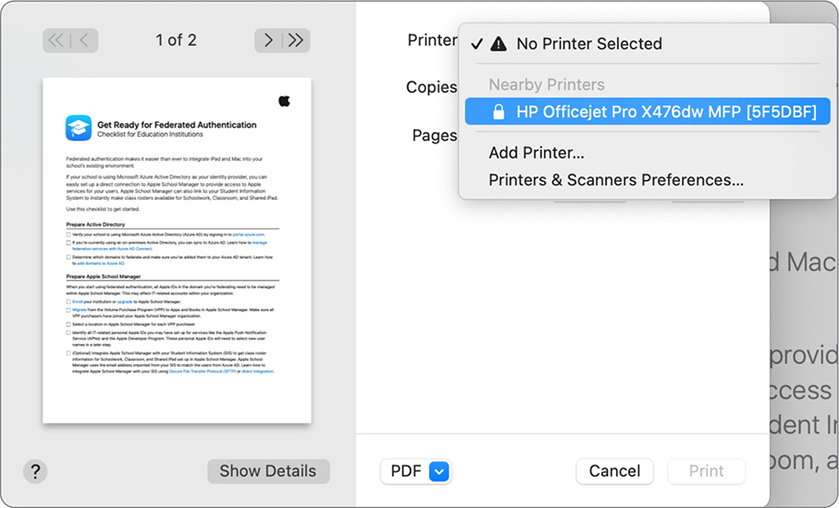
macOS prepares your printer.

Confirm that your printer is available in the Printer menu.

Manually Configure a Printer
If the network printer doesn’t support automatic network discovery with Bonjour, you must configure it manually. Also, if a directly attached printer doesn’t automatically configure, you can manually add it. Add a new printer or multifunctioning device in one of these ways:
 From any app, open a Print dialog by choosing File > Print. Next, from the Printer menu, choose Add Printer.
From any app, open a Print dialog by choosing File > Print. Next, from the Printer menu, choose Add Printer.
 Open System Preferences and click the Printers & Scanners icon. Click the Add (+) button at the bottom of the Printers list.
Open System Preferences and click the Printers & Scanners icon. Click the Add (+) button at the bottom of the Printers list.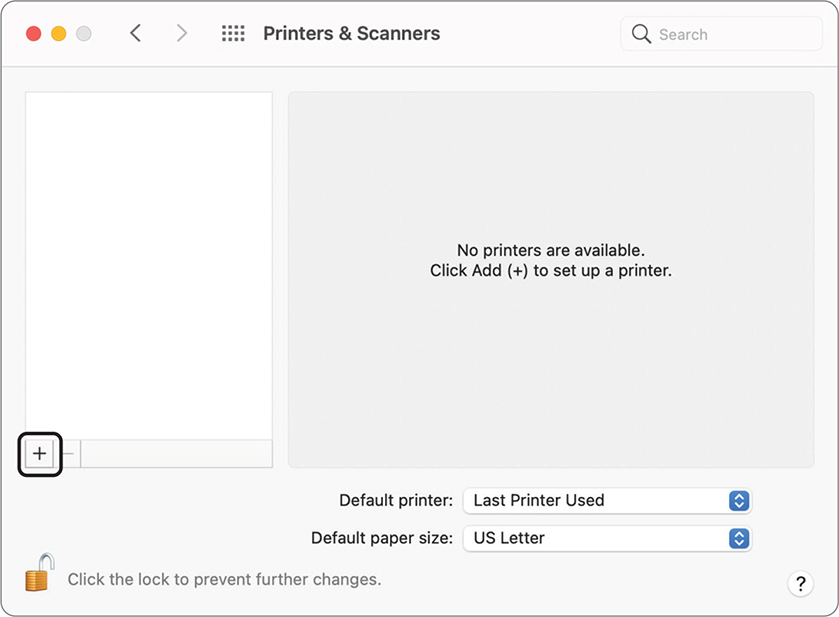
The Add Printer window features several panes for selecting a printer or multifunctioning device. Access these panes by clicking the following buttons in the toolbar:
 Default (printer icon)—Use the browser in this pane to find and select directly attached USB printers and network printers discovered using Bonjour, AirPrint, or network directory services.
Default (printer icon)—Use the browser in this pane to find and select directly attached USB printers and network printers discovered using Bonjour, AirPrint, or network directory services.
 IP (globe icon)—Use this pane to manually enter the IP address or DNS host name of a Line Printer Daemon (LPD), IPP, or HP JetDirect printer. You must choose the appropriate protocol from the menu and enter the printer’s address. Entering a printer queue is usually optional.
IP (globe icon)—Use this pane to manually enter the IP address or DNS host name of a Line Printer Daemon (LPD), IPP, or HP JetDirect printer. You must choose the appropriate protocol from the menu and enter the printer’s address. Entering a printer queue is usually optional.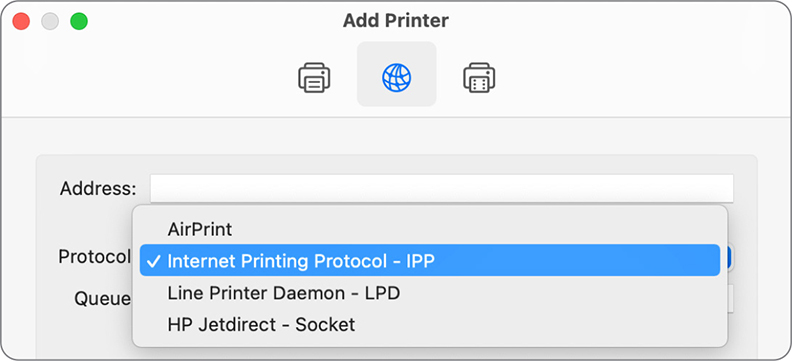
 Windows (printer icon)—Use this pane to select printers shared with the Server Message Block (SMB) printer sharing protocol. Double-click an SMB server and authenticate to access the server’s shared printers. For more information, see “Use your Mac to print to a printer connected to a Windows computer,” at support.apple.com/guide/mac-help/mchlp2437 in the macOS User Guide.
Windows (printer icon)—Use this pane to select printers shared with the Server Message Block (SMB) printer sharing protocol. Double-click an SMB server and authenticate to access the server’s shared printers. For more information, see “Use your Mac to print to a printer connected to a Windows computer,” at support.apple.com/guide/mac-help/mchlp2437 in the macOS User Guide.
An advanced configuration option is also available if you want to manually enter the printer location, but you should do so only when macOS can’t properly auto-locate a printer. The Advanced button is hidden by default. To reveal this button, Control-click in the Add Printer window toolbar. Then choose Customize Toolbar from the menu.
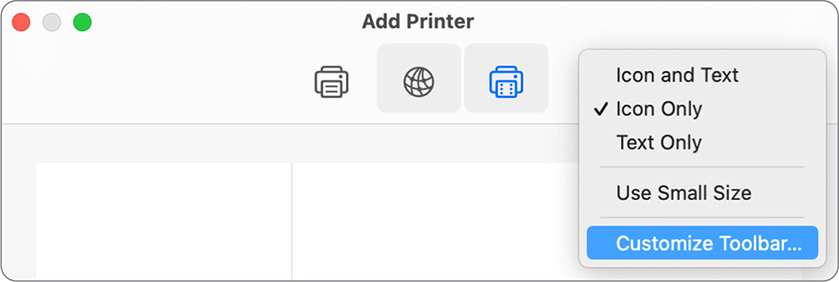
Drag the Advanced button to the toolbar, then click Done. You can click Advanced (the gear icon), then start configuring the printer by choosing the printer type.
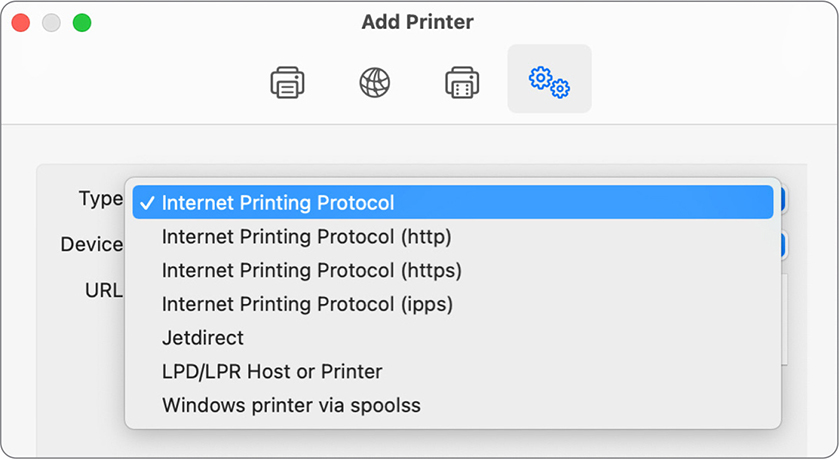
After you choose a printer or multifunctioning device from the top half of the new printer configuration dialog, macOS completes the bottom half for you using information it discovered, which includes selecting the appropriate printer driver if possible. The Name and Location fields are there to help you identify the device. Set those to anything you like.

When you add a new printer, the Add window might include a message that “The selected printer software is available from Apple. Click Add to download it and add this printer.” Your Mac displays this message if the following are true:
 You are logged in as an administrator user (or you are logged in as a standard account user who is a member of the lpadmin group).
You are logged in as an administrator user (or you are logged in as a standard account user who is a member of the lpadmin group). The option “Automatically keep my Mac up to date” is not selected in Software Update preferences.
The option “Automatically keep my Mac up to date” is not selected in Software Update preferences. You add a printer that your Mac doesn’t have the driver for already.
You add a printer that your Mac doesn’t have the driver for already. Your Mac is connected to the internet.
Your Mac is connected to the internet.
If you meet all the conditions and your Mac displays the message, click Add to download the printer driver and add the printer.
If macOS doesn’t ask you to download and add the printer driver (or you aren’t connected to the internet), macOS selects a generic printer driver and displays a message that the printer driver may not let you use all the features of the printer.

If Apple doesn’t provide a suitable printer driver, you may be able to select a built-in printer driver. To select a printer driver, choose Select Software from the Use menu.

You can manually scroll through the list of installed printer drivers, but using the Filter field may be quicker. After you select an appropriate printer driver, click OK to use that driver. The following figure displays all of the default printer drivers that come with macOS Big Sur.

If your Mac doesn’t already have an appropriate printer driver for your printer, you may be able to get a printer driver directly from the printer manufacturer. Try using Software Update to automatically install printer drivers before you try downloading printer drivers from the printer manufacturer.
If you already downloaded and installed any other printer drivers, the Printer Software window displays additional printer drivers. The following figure shows the Printer Software window on a Mac that has drivers installed from “HP Printer Drivers v5.1 for macOS” at support.apple.com/kb/DL1888 as an example.

After you select the printer driver you want to use and click OK, the Printer Software window closes. The Use menu displays the printer driver you selected. Click Add to add the selected printer.

To select a printer driver that you downloaded directly from the printer manufacturer, choose Other from the Use menu; then in the open dialog, select the printer driver and click Open.

If no printer driver is available for your printer, you can use a built-in generic printer driver.
If you configure an LPD printer connection, you must manually specify the appropriate printer driver. This step can occur with HP JetDirect and SMB printer connections.
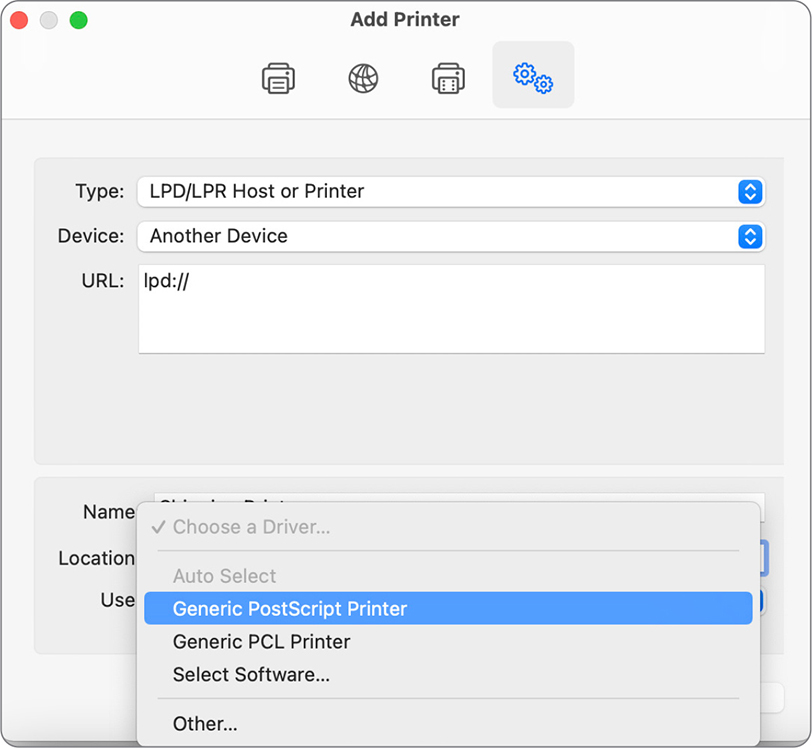
If you configure an IP printer, macOS displays an additional dialog where you can select special printer options. After you complete the printer configuration, open the Print dialog from any app, or from Printers & Scanners preferences, and verify that the printer is added.
In Printers & Scanners preferences, you can tell which printers are network printers if their location is shown as something different than your local Mac computer sharing name.

Some printer drivers include additional functionality. For example, the previous screenshot shows a multifunctioning device with a Scan tab, which indicates that macOS configured the scanning driver software. If your multifunctioning device doesn’t include the Scan tab, try using Printers & Scanners preferences to remove the multifunctioning device, then add it again.
Note ![]()
You can use Terminal to add printers, and in Apple Remote Desktop, you can choose Manage > Send UNIX Command to create printers on many Mac computers at the same time. The man pages for lpadmin, cupsenable, and cupsaccept have more information.
Modify an Existing Printer
You may have to edit a printer configuration after you set it up. Depending on the printer model, you may not be allowed to modify the print driver settings from Printers & Scanners preferences. In that case, to change a printer’s selected driver you must delete the printer and add it again. From Printers & Scanners preferences, you can:
 Remove a printer configuration—Select the item you want to delete from the printer list, then click the Remove (–) button at the bottom of the list.
Remove a printer configuration—Select the item you want to delete from the printer list, then click the Remove (–) button at the bottom of the list. Set printing defaults—From the two menus at the bottom of Printers & Scanners preferences, choose the default printer and paper size. Be careful when you set the default printer for Last Printer Used. You will have no permanent default printer and the default destination for print jobs might constantly change.
Set printing defaults—From the two menus at the bottom of Printers & Scanners preferences, choose the default printer and paper size. Be careful when you set the default printer for Last Printer Used. You will have no permanent default printer and the default destination for print jobs might constantly change.
 Open a print queue—Select a printer from the list and click the Open Print Queue button. Details on print queues are covered later in this lesson.
Open a print queue—Select a printer from the list and click the Open Print Queue button. Details on print queues are covered later in this lesson. Edit an existing configuration and check supply levels—Select a printer from the list, then click the Options & Supplies button. In the resulting dialog, you can edit the printer configuration—including changing the printer name, changing the location, and if available, checking the printer supply levels—and open the printer hardware configuration utility.
Edit an existing configuration and check supply levels—Select a printer from the list, then click the Options & Supplies button. In the resulting dialog, you can edit the printer configuration—including changing the printer name, changing the location, and if available, checking the printer supply levels—and open the printer hardware configuration utility.
 Manage scanning—Select a multifunctioning device from the list and click the Scan button. From this interface, open the scanner image capture interface or enable local network scanner sharing.
Manage scanning—Select a multifunctioning device from the list and click the Scan button. From this interface, open the scanner image capture interface or enable local network scanner sharing.
Share Printers
Your Mac shared print service is made available with IPP printer sharing protocols. Although macOS and Windows are compatible with IPP, different versions of Windows might require additional drivers for IPP. IPP supports automatic printer driver configuration and installation for macOS, so when another Mac user connects to your Mac shared print service, that user’s Mac automatically selects, and downloads if necessary, the appropriate printer drivers.
The CUPS-shared print service also allows other network clients to locate your shared printer configurations with Bonjour. Different versions of Windows might require additional drivers for Bonjour. Alternatively, network clients can enter your Mac computer’s IP address or DNS host name to access your Mac shared print service. Configuring your Mac computer’s identification for providing network services is covered in Lesson 25, “Manage Host Sharing and Personal Firewall.”
Users can’t access shared print services on a Mac in sleep mode. But you can configure your Mac to not sleep, or to wake from sleep when other users access those resources. Use Energy Saver preferences (for desktop Mac computers) or Battery preferences (for notebook Mac computers) to enable the appropriate option to wake for network access (the option varies depending on the configuration of your Mac). See “Share your Mac resources when it’s in sleep,” at support.apple.com/guide/mac-help/mh27905 in the macOS User Guide, and see Reference 28.3, “Sleep Modes, Logout, and Shutdown,” for more information.
To share printers from your Mac, open Sharing preferences, then unlock if necessary. Select the Printer Sharing checkbox to enable printer sharing. Selecting this checkbox configures cupsd (which is always running in the background) to listen for IPP print service requests on TCP port 631.
By default, no printers are shared. To enable sharing for printer configurations, select the checkboxes next to the printers you want to share. Optionally, you can limit who is allowed to print to your shared printers. By default, all users are allowed access to your shared printing devices. To limit access, select a shared device from the Printers list, then click the Add (+) button at the bottom of the Users list.
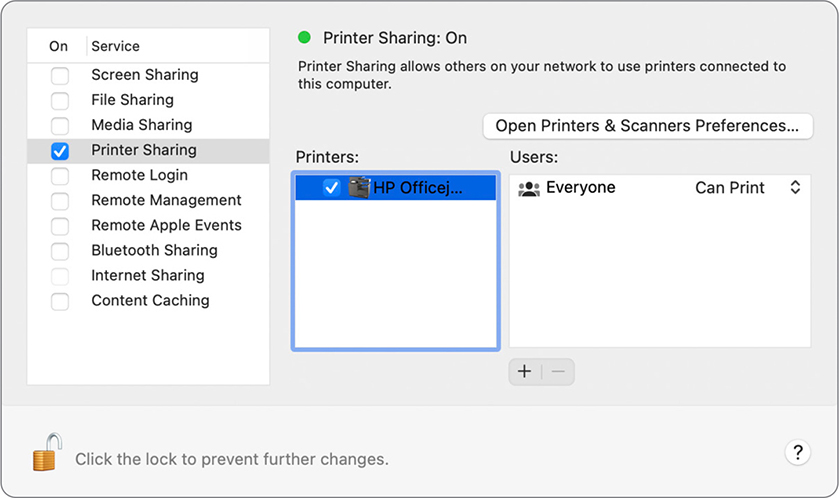
A dialog appears where you can select user or group accounts to whom you want to grant access to the printer. After you add an account, macOS automatically denies access to guest users by configuring No Access for Everyone in the Users list. Also, with limited printing access enabled, users have to authenticate to print to your shared printer.
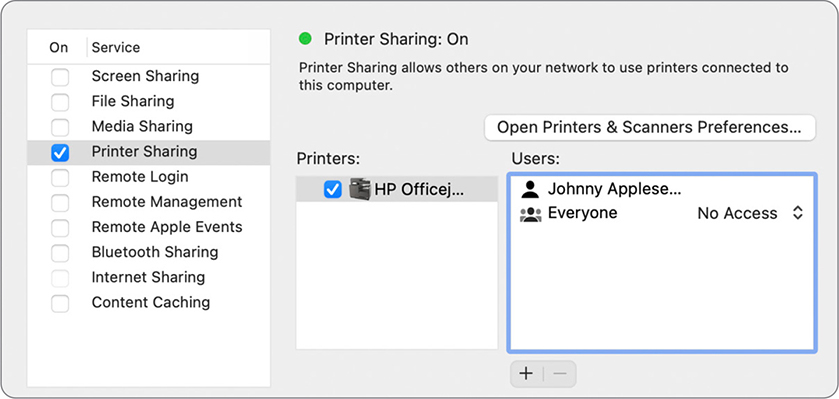
Share only printers that other Mac users can’t otherwise discover. If you share a network printer that’s already available on your network, other Mac users will discover that printer listed multiple times in the Nearby Printers list.
Reference 27.3
Manage Print Jobs
This unified Print dialog has two modes. The basic mode enables you to preview and start a print job using default settings, and the details mode lets you specify any page or print option and manage print setting presets. Some apps, especially graphic design and desktop publishing apps, use custom dialogs for printing that might look different from the standard Print dialog covered in this lesson.
Start a Print Job
To start a print job using default print settings, from an app choose File > Print (or press Command-P). Some apps bypass the Print dialog and send the print job to your default printer when you use Command-P.
When the Print dialog appears, depending on app support, it may slide out of the app’s window title bar or it may also appear as its own dialog. Most apps show a print preview, and some might show the basic print options. The default printer and print preset are selected, but you choose the number of pages, copies, and duplex (two-sided) options, if available. Customizing printer presets is covered in the next section of this lesson.
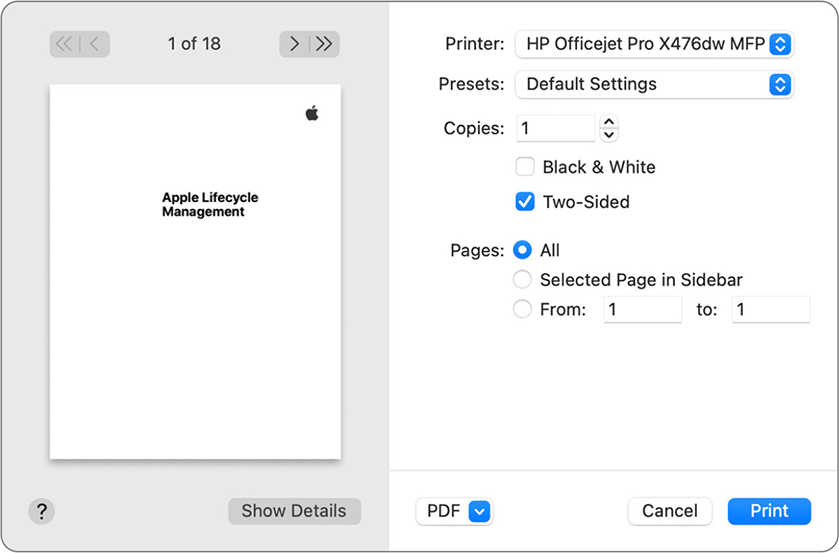
When the print job is started, macOS automatically opens the print queue app associated with the destination printer. Although no window opens if the print job is successful, you can click the print queue in the Dock.
Configure Detailed Print Settings and Presets
To start a print job that uses custom print settings, from an app open the Print dialog. When you open the Print dialog, the default printer and print presets are selected, but you can choose other configured printers or presets from the associated menu.
Clicking the Show Details button expands the Print dialog to its full details mode. In the full details mode, you can click the Hide Details button to return to the basic Print dialog mode. The Print dialog also remembers which mode you last used for each app.
On the left side of the detailed Print dialog, you can page through a preview of the print job, much like the preview in the basic Print dialog. Changes you make to the page layout settings are instantly reflected in the preview. On the right side of the dialog, you can configure possible print settings for most apps. The top half features more detailed page setup and print settings.

Settings on the bottom half vary depending on the app you’re printing from and your printer driver. You can choose a category of print settings to modify from the menu that separates the print settings from top to bottom. The settings list and configuration options vary for different apps, printers, and printer drivers. The following figure displays the options available when printing a Keynote document.
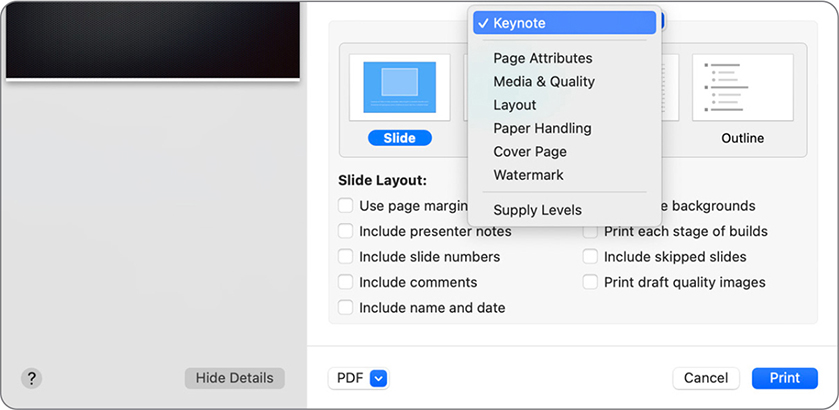
To save the current print settings as a preset, choose “Save Current Settings as Preset” from the Presets menu. Select whether you want this preset to apply to all printers or just the currently selected printer. By saving a preset, you make it accessible from the Presets menu in the details view of any Print dialog. The print presets are saved in ~/Library/Preferences/ in com.apple.print.custompresets.plist for presets that apply to all printers, and in com.apple.print.custompresets.forprinter.printername.plist for presets for a specific printer, so each user has their own custom print presets. Print presets apply to all apps.
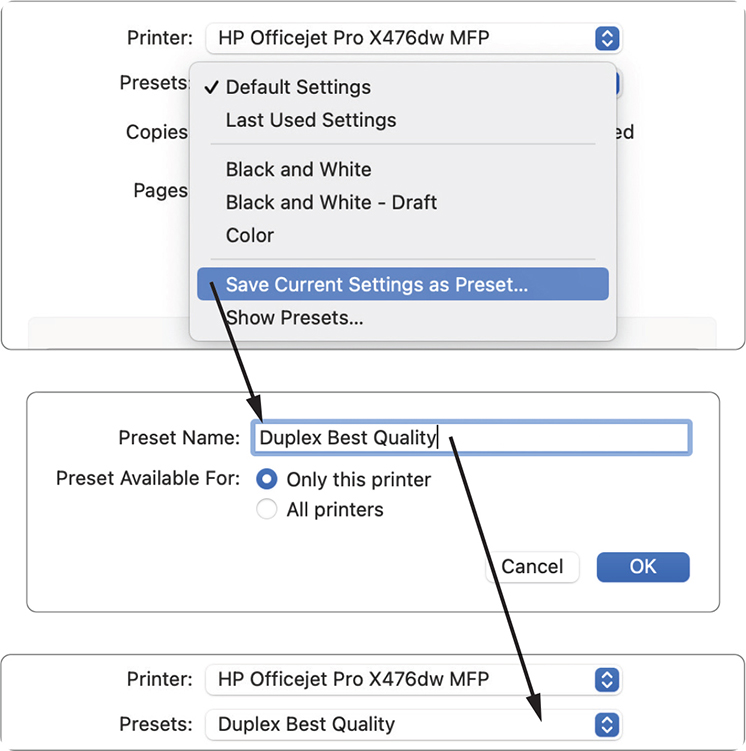
To manage existing print presets, open the print Presets dialog by choosing Show Presets from the Presets menu. In the print Presets dialog, select a preset to inspect its settings and values, and optionally use the Delete and Duplicate buttons at the bottom of the presets list. If you double-click a print preset, you can rename it. When you finish managing print presets, click OK to save the changes and return to the Print dialog.

Create PDF Documents
macOS includes built-in Portable Document Format (PDF) architecture and editing tools, including tools to create PDF documents or perform basic editing. Any app that can print can also generate high-quality PDF documents. In any Print dialog, click the PDF button. A menu appears, which you can use to save a PDF to any location.

From the PDF menu, you can also choose a PDF workflow that accepts and processes PDF files. Some preset workflows are built in, but you can add your own PDF workflows by choosing Edit Menu from the PDF menu. Or, depending on who needs access to them, you can manually add PDF workflows to /Library/PDF Services or ~/Library/PDF Services. To create custom PDF workflows, use Automator to create a Print Plugin or use Script Editor.
You can also edit PDFs in Preview. Reference 20.2, “Manage App Extensions,” has more information.
Manage Printer Queues
When a print job starts, the spool file is placed in /private/var/spool/cups, and CUPS takes over to process the file and send it to the printer. When you print from an app or the Finder, macOS opens a print queue app to manage the print job. If a job completes quickly, the file is in the print queue only for a few moments, and the print queue app quits when the print job is done.
If macOS detects an error with a printer, it stops all print jobs that are in the printer queue. You can still start print jobs, but they just back up in the queue.
To manage print job queues, access the printer queue app in one of the following ways:
 If a printer queue is open, click its icon in the Dock. In the following example screenshot, the printer queue’s Dock icon shows a “1” in the red badge icon in the upper right of the icon, indicating that there is currently a job in the queue. Also, as indicated by the orange connection badge in the lower-left corner of the icon, this printer queue has network issues that are preventing the print job from completing.
If a printer queue is open, click its icon in the Dock. In the following example screenshot, the printer queue’s Dock icon shows a “1” in the red badge icon in the upper right of the icon, indicating that there is currently a job in the queue. Also, as indicated by the orange connection badge in the lower-left corner of the icon, this printer queue has network issues that are preventing the print job from completing.
 You can manually open a printer queue from Printers & Scanners preferences by double-clicking the device in the printer list or by selecting the device from the printer list and clicking the Open Print Queue button.
You can manually open a printer queue from Printers & Scanners preferences by double-clicking the device in the printer list or by selecting the device from the printer list and clicking the Open Print Queue button. You can also manually open a printer queue from the Finder by navigating to ~/Library/Printers and double-clicking a printer.
You can also manually open a printer queue from the Finder by navigating to ~/Library/Printers and double-clicking a printer.
When the printer queue opens, it displays the printer status and queued print jobs.

To pause or resume the jobs in the printer queue, click the Pause or Resume button (the button toggles between the two modes) in the queue app toolbar. To hold or resume a print job, select it from the job list and click the small Hold or Resume button to the right of the print job progress bar (the button toggles between the two). To delete a job, select it from the job list and click the small x button to the right of the print job progress bar.
You can select a job in the printer queue list, then press the Space bar to open a Quick Look preview window for the print job. For a held job, choose Jobs > Resume Job on Page, then specify a page number to resume printing on. You can reorder print jobs in the printer queue by dragging the job you want to reorder in the list. You can also drag jobs from one printer queue window to another.
Other features are available in the printer queue app toolbar. You can reconfigure the printer by clicking the Settings button in the toolbar. Also, for a supported multifunctioning printer, you can click the Scanner button in the toolbar to open the Scanner interface.
You might want to leave often-used printer queues in the Dock for direct access. Control-click the queue app’s Dock icon and, from the shortcut menu, choose Options > Keep in Dock. A benefit to having your printers in the Dock is that you can drag a document on top of a printer icon to quickly print a single copy of the document.

You can also provide quick access to your printer queues by dragging the ~/Library/Printers folder from the Finder to your Dock. Click this folder in your Dock to open a folder with your configured devices.
Reference 27.4
Troubleshoot Print Issues
You will probably experience more printing issues that are caused by hardware rather than software. The following is a series of general print system troubleshooting techniques:
 Check the printer queue app first. The printer queue lets you know if there is a printer connection issue. At the same time, verify that the queue isn’t paused and that no jobs are on hold. Sometimes deleting old print jobs from the queue helps clear the problem.
Check the printer queue app first. The printer queue lets you know if there is a printer connection issue. At the same time, verify that the queue isn’t paused and that no jobs are on hold. Sometimes deleting old print jobs from the queue helps clear the problem. Double-check page and print settings. If the job is printing but doesn’t print correctly, then double-check page and print settings using the Print dialog details mode.
Double-check page and print settings. If the job is printing but doesn’t print correctly, then double-check page and print settings using the Print dialog details mode. Review the PDF output of the app. The CUPS workflow is app > PDF > CUPS > printer. Verifying whether the PDF looks correct lets you know if the source of the problem is with the app or the printing system.
Review the PDF output of the app. The CUPS workflow is app > PDF > CUPS > printer. Verifying whether the PDF looks correct lets you know if the source of the problem is with the app or the printing system. Print from another app. If you suspect the app is the root of the problem, try printing from another app. You can also print a test page while in the printer queue app by choosing Printer > Print Test Page.
Print from another app. If you suspect the app is the root of the problem, try printing from another app. You can also print a test page while in the printer queue app by choosing Printer > Print Test Page. If you have trouble adding a printer and finding an appropriate printer driver, try logging in as an administrator user before you add the printer.
If you have trouble adding a printer and finding an appropriate printer driver, try logging in as an administrator user before you add the printer. Check the printer hardware. Many printers have diagnostic screens or printed reports that help you identify a hardware issue. Many also have a software utility or a built-in webpage that reports errors. Click the Printer Setup button in the printer queue app toolbar to access these management interfaces. Double-check cables and connections. Lastly, contact the printer manufacturer to diagnose printer hardware issues.
Check the printer hardware. Many printers have diagnostic screens or printed reports that help you identify a hardware issue. Many also have a software utility or a built-in webpage that reports errors. Click the Printer Setup button in the printer queue app toolbar to access these management interfaces. Double-check cables and connections. Lastly, contact the printer manufacturer to diagnose printer hardware issues. For directly connected printers, use the peripheral troubleshooting techniques outlined in Lesson 26, “Troubleshoot Peripherals.”
For directly connected printers, use the peripheral troubleshooting techniques outlined in Lesson 26, “Troubleshoot Peripherals.” For network printers, use network troubleshooting techniques described in Lesson 23, “Troubleshoot Network Issues,” and Lesson 24, “Manage Network Services.”
For network printers, use network troubleshooting techniques described in Lesson 23, “Troubleshoot Network Issues,” and Lesson 24, “Manage Network Services.” Delete and reconfigure printers. From Printers & Scanners preferences, delete and reconfigure a problem printer using the techniques described earlier in this lesson. Doing so resets the device drivers and queue.
Delete and reconfigure printers. From Printers & Scanners preferences, delete and reconfigure a problem printer using the techniques described earlier in this lesson. Doing so resets the device drivers and queue. Reset the entire print system. Open Printers & Scanners preferences. If you’re logged in with a standard user account, click the lock and provide administrator credentials. Control-click in the printers list and choose “Reset printing system” from the shortcut menu. Click Reset in the verification dialog. Following these steps clears configured devices, shared settings, custom presets, and queued print jobs.
Reset the entire print system. Open Printers & Scanners preferences. If you’re logged in with a standard user account, click the lock and provide administrator credentials. Control-click in the printers list and choose “Reset printing system” from the shortcut menu. Click Reset in the verification dialog. Following these steps clears configured devices, shared settings, custom presets, and queued print jobs.
 For non-AirPrint printers, remove printer drivers by moving the contents of /Library/Printers to another location.
For non-AirPrint printers, remove printer drivers by moving the contents of /Library/Printers to another location. Review CUPS log files. Like other system services, CUPS writes important activity to log files. You can access the logs while in any printer queue app by choosing Printer > Error Log. This opens Console to the CUPS error_log report. While in Console, you can check the access_log and page_log reports. The error_log file may not exist if the CUPS service hasn’t logged print errors. The files for these reports are in /private/var/log/cups.
Review CUPS log files. Like other system services, CUPS writes important activity to log files. You can access the logs while in any printer queue app by choosing Printer > Error Log. This opens Console to the CUPS error_log report. While in Console, you can check the access_log and page_log reports. The error_log file may not exist if the CUPS service hasn’t logged print errors. The files for these reports are in /private/var/log/cups. Reinstall or update printer drivers. You can use Software Update preferences to check for system and printer updates. You can also check the printer manufacturer’s website for the latest printer driver updates. If you’re using an AirPrint-enabled printer, you can check with the manufacturer to determine if there’s an update for your printer model (as opposed to a printer driver update).
Reinstall or update printer drivers. You can use Software Update preferences to check for system and printer updates. You can also check the printer manufacturer’s website for the latest printer driver updates. If you’re using an AirPrint-enabled printer, you can check with the manufacturer to determine if there’s an update for your printer model (as opposed to a printer driver update).
For advanced print system management and troubleshooting, go to the web interface to CUPS for your Mac at http://localhost:631 and follow the instructions.
See “Solve printing problems on Mac” at support.apple.com/guide/mac-help/mh14002 in the macOS User Guide for more information. Or in Printers & Scanners preferences, click the Help (question mark) button.
Exercise 27.1
Configure Printing
Note ![]()
If you don’t meet these prerequisites, reading the exercises will enhance your knowledge of the processes.
Configure a Bonjour Printer
In this exercise, you discover and configure a network printer through the Bonjour service discovery protocol.
If necessary, log in as Johnny Appleseed.
Open Printers & Scanners preferences.
If necessary, click the lock button, then authenticate as Local Administrator.
Click the Add (+) button under the printer list.

The Add Printer window opens and shows a list of nearby printers.
Depending on the local network environment, the contents of this list on your network may vary. See Reference 27.2, “Configure Printers and Scanners,” for more information.
Select the printer you want to use in the list of available printers.
Depending on the type of printer, one of several things might happen:
 If a driver for the printer is installed on your Mac, is available from the Mac sharing the printer, or is available from the printer, it’s selected and shown in the Use menu.
If a driver for the printer is installed on your Mac, is available from the Mac sharing the printer, or is available from the printer, it’s selected and shown in the Use menu.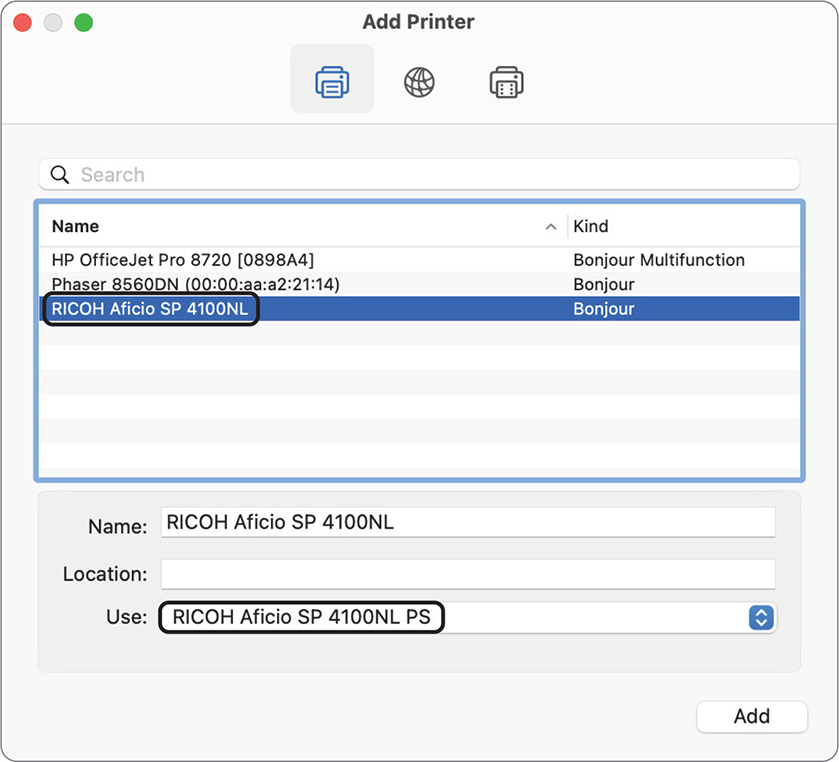
 If the driver isn’t installed locally, a generic driver may be available to provide basic printing.
If the driver isn’t installed locally, a generic driver may be available to provide basic printing.
In this case, find and install a driver (probably from the printer manufacturer). Close the Add Printer window and try again after you find and install the appropriate driver.
 If the printer is AirPrint compatible, you are able to add it without having a printer-specific driver.
If the printer is AirPrint compatible, you are able to add it without having a printer-specific driver.
With the printer selected, click Add.
Your Mac fetches information about optional features from the printer (or the Mac sharing it), then completes the setup process. Your Mac is now configured to print to this printer.
When the new print queue is set up, select it and click the Open Print Queue button.

The window that appears lets you inspect and change settings for the print queue. Depending on the printer capabilities, options may include a Scanner button.
Click the Settings button.

A dialog opens that enables you to inspect and change information about the print queue configuration. These settings are also accessible from Printers & Scanners preferences when you click the Options & Supplies button.
Use the General pane to configure the name and location displayed for the printer. You may find it useful to name printers that would otherwise have their model name listed.
If appropriate, change the name and location to something more descriptive.

The other panes in the Settings dialogs vary considerably between different printer models. You probably won’t find the same options that you see in the following screenshots.
If there is an Options button, click it.

If this printer is shared from a Mac, the Mac controls what options are configured for the printer. If you are connecting to the printer directly, you can change the options.
If there is a Supply Levels button, click it.
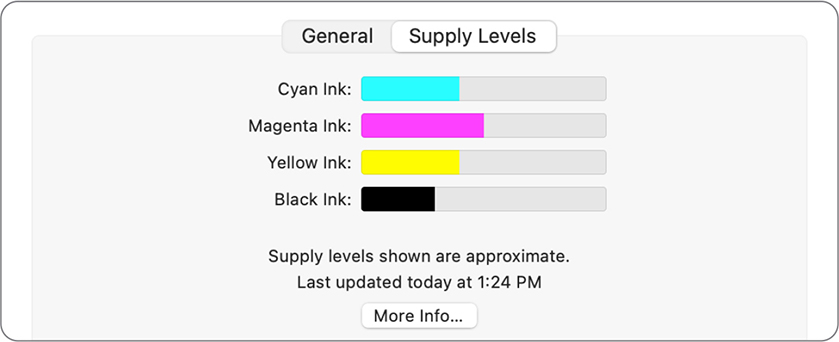
If you are connecting to the printer directly and the printer supports it, you can inspect the printer supply levels.
If there is a Utility button, click it.
If available, this Printers & Scanners pane gives you access to utilities supplied by this printer driver. The functions vary depending on the printer model. Some drivers include a separate utility program, which you can open from this pane.
Click OK to dismiss the Settings dialog.
Quit the printer queue.
The printer queue isn’t an app, but it acts like one, including the Quit option under the “application” menu.
Exercise 27.2
Manage Printing
In this exercise, you explore the Print dialog, including saving print options as a preset, printing to PDF, and managing PDF workflows.
Print to a Printer
In this section, you print to one of the printers you just set up.
If necessary, log in as Johnny Appleseed.
Open TextEdit.
Click New Document (or, if necessary, press Command-N).
Type some text into the document, then save it to your desktop using a name of your choice.
In the TextEdit menu bar, choose File > Print (Command-P).
In the Print dialog, choose a printer from the Printer menu.
Click Show Details.
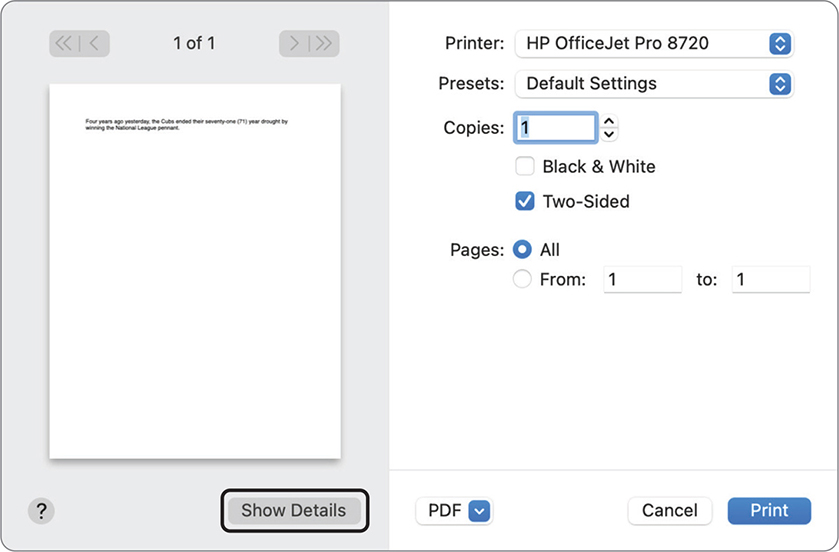
The Print dialog expands to show additional print settings.
Choose Layout from the configuration menu (initially set to TextEdit).
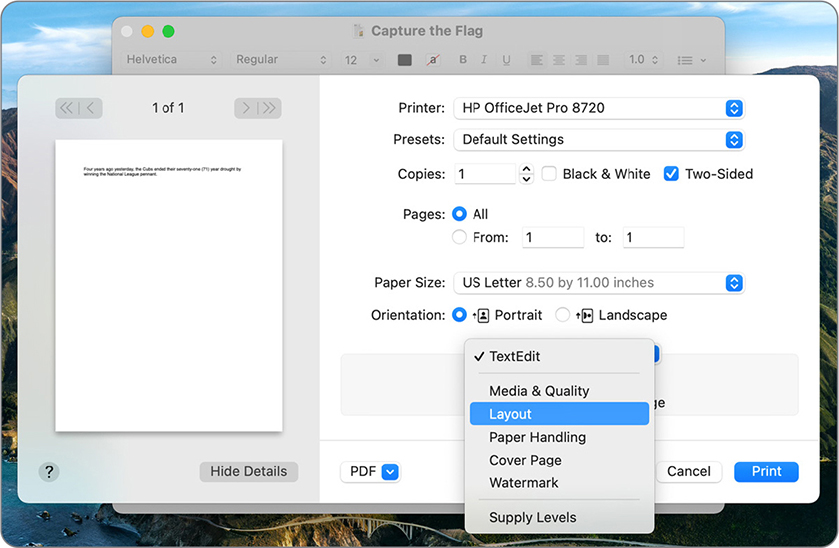
From the “Pages per Sheet” menu, choose 6.
From the Border menu, choose Single Thin Line.
As you change settings, the preview on the left shows the effects.
From the Presets menu, choose “Save Current Settings as Preset.”

Name the preset 6-up with border, make it available for all printers, then click OK.

The print settings are available from the Presets menu whenever you print.
Use the Presets menu to switch between Default Settings and “6-up with border,” then watch the effect on the print settings.
Click Print.
The print queue icon appears in your Dock and shows the number of jobs in the queue (1).

Manage a Print Queue
If possible, click the printer queue in your Dock before it becomes unavailable.
In the queue window, watch as the job is sent to the printer (or server), then is removed from the queue.

If the printer queue is no longer available in the Dock before you’ve had a chance to click it, open Printers & Scanners preferences, select the print queue on the left, then click Open Print Queue.
In the print queue window, click Pause.
Switch to TextEdit, then print the document again.
When you are warned that the printer has been paused, click “Add to Printer.”
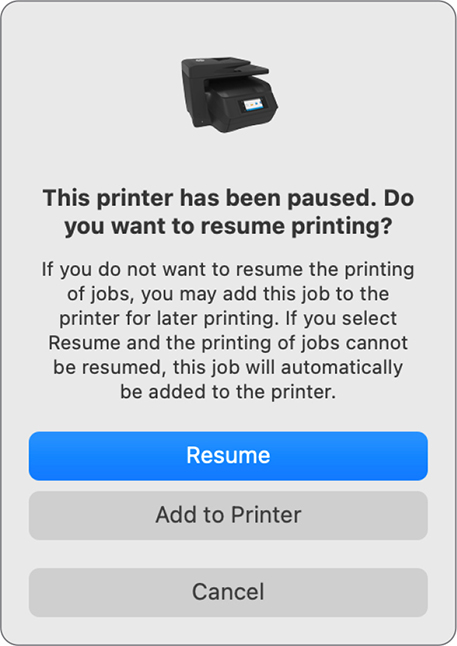
Switch to the print queue window. If your document isn’t shown, quit the print queue, then reopen it from Printers & Scanners preferences. If the first document didn’t successfully print, your document may be listed twice.
Your document is shown as “Ready to Print.”

Preview the print job by double-clicking the document in the print queue or by pressing Command-Y or the Space bar.
Close the Quick Look window and click the Jobs menu.
This menu has options for holding, resuming, or deleting print jobs. Most of the options are also available in the print queue window.
Click the delete (“X”) button to the right of the print job. If the queue contains two documents, delete both of them.
The job is no longer displayed in the print queue.
Quit the print queue.
Print to PDF
Switch to TextEdit, then press Command-P.
Click the PDF button near the bottom left of the Print dialog.

Choose “Open in Preview.”
CUPS produces a PDF version of your document, then opens it in Preview. There are Cancel and Print buttons near the bottom right of the window.
Click Cancel.
This closes the document and quits Preview.
In TextEdit, press Command-P again.
From the PDF menu, choose “Save as PDF.”
Save the PDF to your desktop.
Quit TextEdit.
Exercise 27.3
Troubleshoot Printing
To troubleshoot printing, you must know the print process. In this exercise, you examine print logs and reset the printing configuration.
Examine the CUPS Logs
You can examine system and user event logs in Console. In this exercise, you use Console to examine CUPS logs.
If necessary, log in as Johnny Appleseed.
Open Console.
Select Log Reports from the left column, then select access_log in the second column.

If you printed, entries appear in the access log. The page log may also contain entries for each job.
If the list includes page_log and error_log files, select them and examine their contents.
Quit Console.
Reset Printing
If you can’t print to your printer and you’ve tried other solutions, you can restore the printing system to the macOS defaults. When you reset your printing system to the macOS defaults, you delete printers from your printer list as well as information about completed print jobs and printer presets.
Open Printers & Scanners preferences.
If necessary, click the lock button, then authenticate as Local Administrator.
Press and hold the Control key, then click in the printer list.
Choose “Reset printing system” from the menu that appears.
Click Reset when you’re asked to confirm.
You can add your printers again when the process is complete.
Quit System Preferences.
